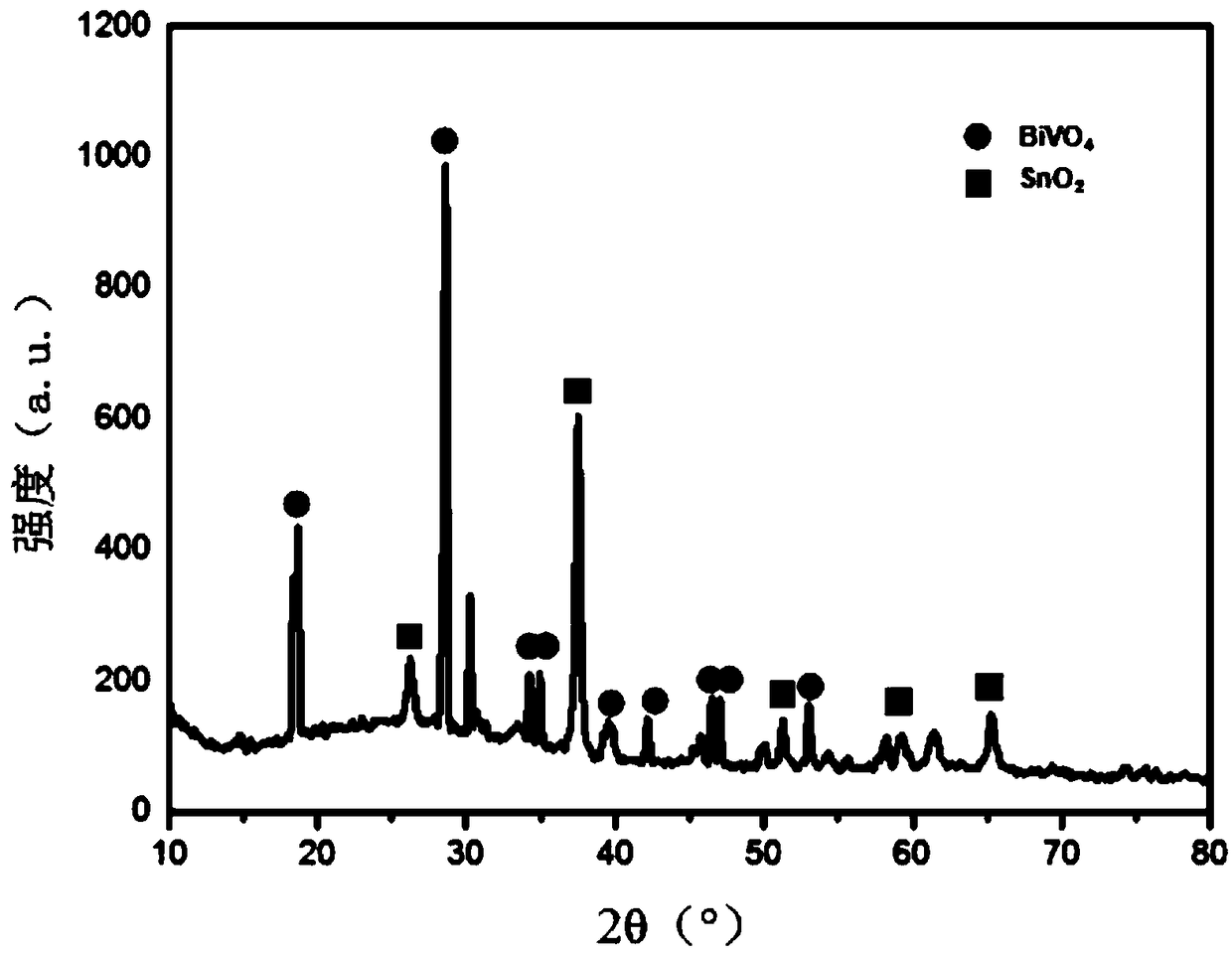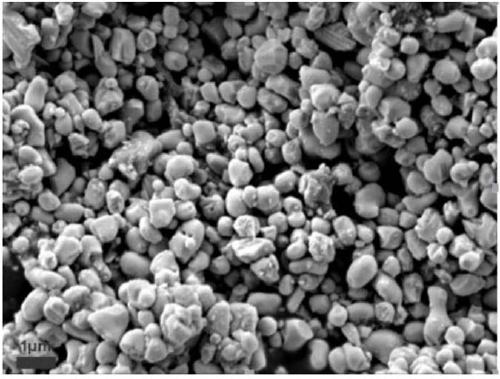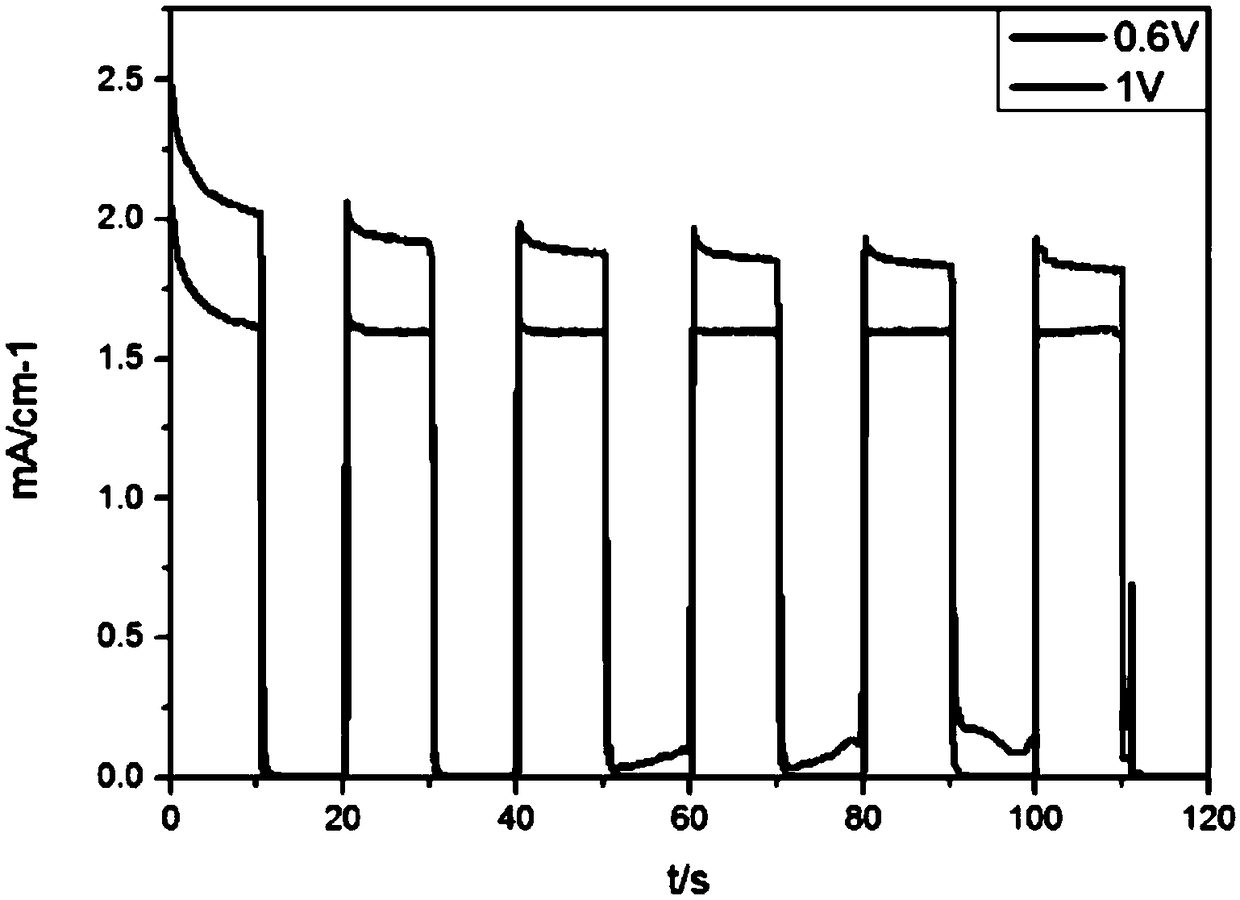Method for treating wastewater and by-producing hydrogen by activating sulfate with photoanode
A technology for treating wastewater and sulfate, applied in chemical instruments and methods, special compound water treatment, light water/sewage treatment, etc., can solve the problems of high cost and limitations, and achieve the effect of mild conditions, simple equipment and simple process
- Summary
- Abstract
- Description
- Claims
- Application Information
AI Technical Summary
Problems solved by technology
Method used
Image
Examples
Embodiment 1
[0038] Bismuth vanadate materials were prepared as follows:
[0039] 0.9g Bi(NO 3 ) 3 ·H 2 O was dissolved in 100 mL of 0.4 M KI solution, and the pH of the solution was adjusted to 1.7 with dilute nitric acid to obtain A solution. 20 mL of absolute ethanol dissolved with 0.23 M p-benzoquinone was added to the solution A under vigorous stirring to obtain a tan solution. Chenhua CHI660 electrochemical workstation was used for constant potential deposition. The above solution was used as the electrolyte, FTO conductive glass was used as the working electrode, Ag / AgCl was used as the reference electrode, and Pt was used as the counter electrode. Using this three-electrode system, FTO conductive glass was used. Potentiostatic deposition. The vanadium precursor solution is placed on the electrode and annealed at a high temperature to obtain a bismuth vanadate material. Soak the obtained bismuth vanadate material in NaOH solution to remove excess oxides on the surface to obtain...
Embodiment 2
[0046] The Pt in Example 1 was replaced by FeNiP-NF as the photocathode, and the photoelectrocatalytic degradation treatment of rhodamine B dye in industrial wastewater was carried out.
[0047] Figure 4 It is the test chart of photoelectrocatalytic degradation of rhodamine B dye under different photocathodes in embodiment 1 and embodiment 2. Depend on Figure 4 It can be seen that the direct photolysis efficiency of rhodamine B dyes only differs by 5% when Pt and FeNiP-NF are used as cathodes respectively, and FeNiP-NF is preferred because of the lower cost of FeNiP-NF.
[0048] From Example 1 and Example 2, it can be seen that using the bismuth vanadate material as the photoanode, using the common sulfate in wastewater as the precursor of sulfate radicals, and adopting the method of photoelectrically activating sulfate, the effect on wastewater degradation is remarkable , the reaction condition is mild, without the need to strengthen the oxidant PMS, it can achieve excell...
Embodiment 3
[0054] A method of using photoanode to activate sulfate to treat waste water and produce hydrogen by-product, the method is: use bismuth vanadate material as photoanode, form a photoelectrocatalytic degradation system together with cathode material and xenon lamp, and treat the Wastewater is degraded by photoelectrocatalysis. Wastewater contains sulfate, the concentration of sulfate is 0.05mol / L; the concentration of pollutants is 50mg / L.
[0055] Wherein, the preparation method of bismuth vanadate material comprises the following steps:
[0056] 1) adding bismuth nitrate to the potassium iodide solution, and then adding an ethanol solution of p-benzoquinone to obtain an electrolyte;
[0057] 2) Using FTO conductive glass as a working electrode, Ag / AgCl as a reference electrode, and Pt as a counter electrode, FTO conductive glass is subjected to constant potential deposition to obtain electrode materials;
[0058] 3) Place the vanadium precursor solution (vanadium acetylacet...
PUM
| Property | Measurement | Unit |
|---|---|---|
| wavelength | aaaaa | aaaaa |
| concentration | aaaaa | aaaaa |
Abstract
Description
Claims
Application Information
 Login to View More
Login to View More - R&D
- Intellectual Property
- Life Sciences
- Materials
- Tech Scout
- Unparalleled Data Quality
- Higher Quality Content
- 60% Fewer Hallucinations
Browse by: Latest US Patents, China's latest patents, Technical Efficacy Thesaurus, Application Domain, Technology Topic, Popular Technical Reports.
© 2025 PatSnap. All rights reserved.Legal|Privacy policy|Modern Slavery Act Transparency Statement|Sitemap|About US| Contact US: help@patsnap.com



